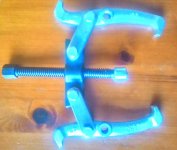Len walls
Member
Ok so for those of you who read my last post you know that I have a 1970 ish 60 hp hydro electric that had failed into forward, the gear oil had turned to custard and the solenoid readings where all over the countryside.
Thanks to some good advice I persisted in my dog and bone attitude and went ahead and removed the lower unit.
I found a broken lead to one solenoid, that was the good news, the bad news was I also discovered the source of the custard gear oil, a really leaky top seal on the drive shaft.
After spending a couple hundy I really shouldn't have ( I'm sure everyone here knows all about that) I'm back in the workshop proceeding to work on pulling out what ever hair I have left.
Does anyone have any advice on replacing this seal, I've removed the four bolts on the round (what I would have imagined to be cap) beneath the impeller housing, the shaft is loose in the seal but the cap won't budge.
I don't want to attempt to force it off in case it's not a cap or I'm missing something.
Any help would be much appreciated.
Thanks to some good advice I persisted in my dog and bone attitude and went ahead and removed the lower unit.
I found a broken lead to one solenoid, that was the good news, the bad news was I also discovered the source of the custard gear oil, a really leaky top seal on the drive shaft.
After spending a couple hundy I really shouldn't have ( I'm sure everyone here knows all about that) I'm back in the workshop proceeding to work on pulling out what ever hair I have left.
Does anyone have any advice on replacing this seal, I've removed the four bolts on the round (what I would have imagined to be cap) beneath the impeller housing, the shaft is loose in the seal but the cap won't budge.
I don't want to attempt to force it off in case it's not a cap or I'm missing something.
Any help would be much appreciated.
Last edited:



